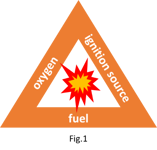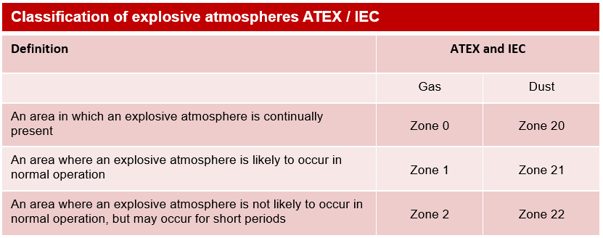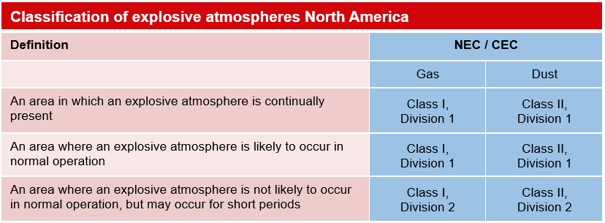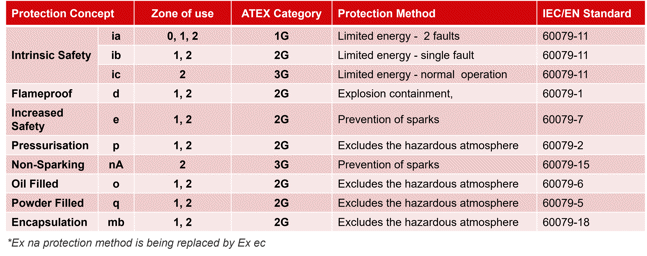Selecting equipment for explosive atmospheres
The nature of many industrial processes means an explosive gas, vapor or dust atmosphere is present. Whether this be as a by-product of the process or as an inherent process hazard, necessary precautions must be taken to ensure that a fire or explosion does not take place.
The explosion triangle fig 1. shows the three components which would allow a fire or explosion to take place:
|
 |
Fuel sources
Fuel sources from industrial processes are typical split into two types:
- "Gas" including vapor and mists. Typical "Gas" fuel sources can include Ammonia, Methane, Hydrogen, Propane, Ethane and Butane often found in Chemical and Petrochemical processes.
- "Dust" including fibers and flyings. Typical "Dust" fuel sources can include dust layers and clouds from Metal processing, Food & Beverage, Pharmaceuticals, Paper and Wood.
Ignition sources
Potential sources of ignition are wide reaching and can include sparks from cutting & welding equipment, hot surfaces, friction, impact sparks, electrostatic discharge, lightning and many more.
Oxygen
Consideration should be given to not only oxygen in the air, but also oxidizing agents such as Chlorine.
Explosion protection
A fire or explosion can be prevented by effectively removing one of the legs of the triangle. The concept of explosion protection is to do just this, either by removing or restricting presence of oxygen, fuel or potential sources of ignition. This is achieved by careful consideration of the process environment, process design and by employing equipment suitable for the protection methods chosen.
What is the ATEX directive?
ATEX is derived from the French term "ATmosphères EXplosibles".
There are two European Union ATEX directives, the “equipment directive” for manufacturers of equipment for use in potentially explosive atmospheres (ATEX 114) 2014/34/EU and the “workplace directive” for the health and safety of workers at risk from explosive atmospheres (ATEX 137) 1999/92/EC.
The IEC 60079 series of standards, which also form the basis of the EU 2014/34/EU (ATEX) directive give detailed guidance on:
- Evaluation and classification of hazardous areas within a plant.
- Selection and implementation of relevant equipment explosion protection methods.
Intrinsic safety ATEX barriers
What is ATEX zone classification?
The ATEX 1999/92/EC workplace directive sets out the minimum requirements for improving the health and safety of workers potentially at risk from explosive atmospheres.
Compliance with this directive includes a requirement to fully assess and document all potential explosion risks, including:
- Flammable/Explosive material characteristics.
- Source and grades of potential release (continuous, primary, secondary).
- Ventilation & dispersion.
This information is then used to characterize the areas of a plant into zones based on the likelihood and frequency of an explosive atmosphere being present.

ATEX zones vs Class/Div
Although the zone system is based on IEC standards and is widely adopted internationally, there are some national regulations that employ alternative methods. A case in point is the North American regulations relating to construction and operation of electrical systems.
The US National Electrical Code (NEC) and the Canadian Electrical Code (CEC) have alternative definitions for hazardous areas, which use a Class and Division format to differentiate them.

Although it should be noted that as the NEC/CEC regulations evolve, the zone model is increasingly being accepted.
What are ATEX equipment groups and categories?
The ATEX equipment directive 2014/34/EU applies to electrical and/or mechanical equipment used on the surface / above ground, below ground and on fixed offshore installations.
Specifically, the directive covers:
- All equipment intended for use in potentially explosive atmospheres, and which are capable of causing an explosion through their own potential sources of ignition.
- Protective systems intended for use in potentially explosive atmospheres.
- Components, which are defined as any item essential to the safe functioning of equipment and protective systems but with no autonomous function.
Manufacturers are responsible for ensuring all relevant products have a conformity assessment carried out in relation to the specific product type.
Equipment groups
Equipment and products which fall within the scope of the Directive are divided into 2 groups:
Group I – Mining industry
Applies to underground equipment in mines and any associated surface machinery exposed to risk of firedamp and/or combustible dust emissions.
Group II – Non-Mining Industry
Applies to equipment for use in for example the process industry where explosive atmospheres caused by gases, vapors, mists or air/dust mixtures are likely to occur.
Equipment categories
Each equipment group is further divided into categories depending on the level of protection offered.
Group I categories:
M1:
Equipment in this category is intended for mining use and is required to remain functional in the presence of an explosive atmosphere.
M2:
Equipment in this category is intended for mining use but be de-energized in the event of an explosive atmosphere.
Group II categories:
Equipment category 1
Equipment in this category is intended for use in Zone 0 areas (gases) or Zone 20 (dusts) and must have a very high level of inherent protection. The equipment must provide protection, even in the event of expected and rare faults. Safety should be guaranteed in the case of two independent faults occurring.
|
Equipment category 2 Equipment in this category is intended for use in Zone 0 areas (gases) or Zone 20 (dusts) and must have a very high level of inherent protection. The equipment must provide protection, even in the event of expected and rare faults. Safety should be guaranteed in the case of two independent faults occurring. |
Equipment category 3
Equipment in this category is intended for use in Zone 2 (gases) or Zone 22 (dusts). Equipment must provide necessary protection during normal operation.
ATEX Protection methods
Various recognized explosion protection methods can be used depending on the nature of the hazard and on the specific process involved.
Referencing relevant sections of the IEC 60079 series of standards and specification, gives full requirements for each type of protection method.
The tables below summarize the common protection methods for both gas and dust; showing which zones they are applicable for, the method of protection and the relevant IEC 60079 reference.
Protection Types - Gas

Protection Types - Dust


